Social media outreach: How our politicians fare
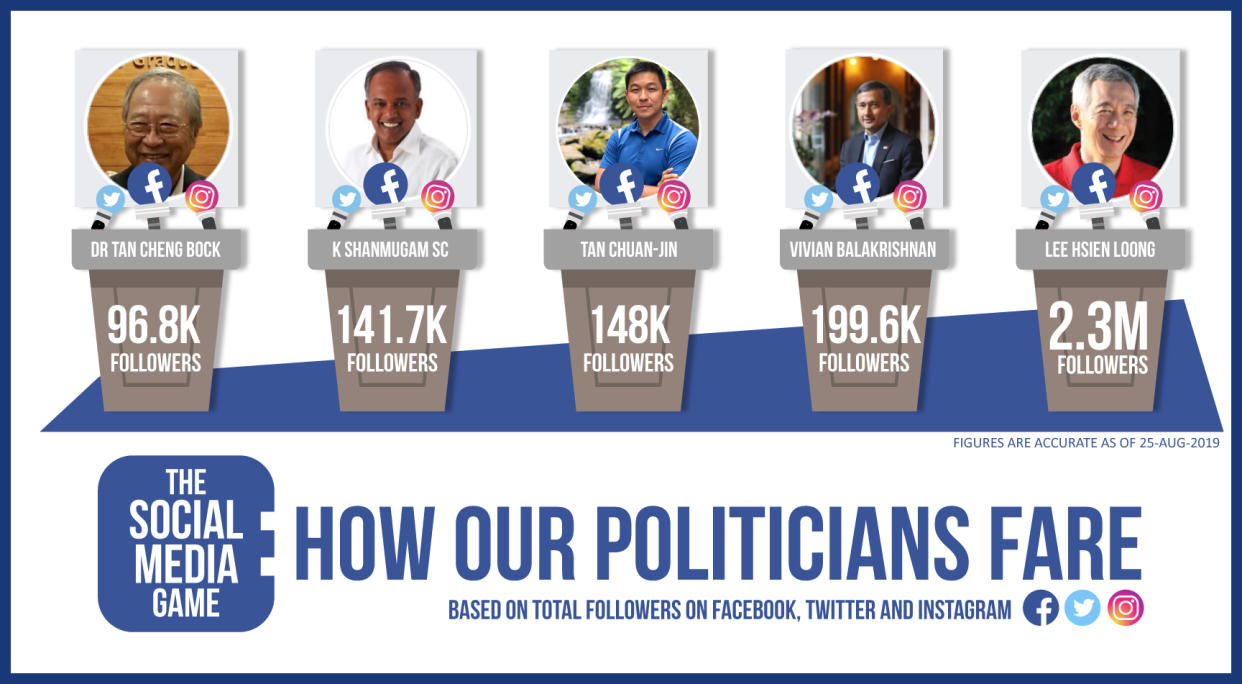
By Chandreyee Ray
SINGAPORE — While no politician in Singapore has reached Trumpian levels of tweeting policy announcements, nearly everyone knows that they need some kind of social media outreach mechanism to stay in the picture. Unsurprisingly, every member of Singapore’s Cabinet has a public Facebook page, with most boasting upwards of 30K-50K followers. Members of the opposition are not left behind either.
Listed below are the local politicians that have accounts on all three major social media platforms - Facebook, Twitter, and Instagram.



These platforms provide politicians immediate (sometimes real-time) feedback, allow them to easily and inexpensively weigh public opinion, and help engage the tech-savvy first-time voter generation. Ideally, social media interaction should be more like a personal conversation, compared to a generic political rally. As elections draw near, we take a look at how effectively our local politicians are able to harness the power of social media.

The top numbers come from PM Lee, who has 1.2 million followers on Facebook, and over another million on Twitter and Instagram combined. Hefty figures do not come easy – PM Lee has 12 people manning his Facebook page, though he always signs off as ‘LHL’ on updates he pens himself.
Meanwhile, former leader of the Workers' Party Low Thia Khiang doesn’t have a single social media page. His successor Pritam Singh does, and he manages a respectable 26.2K and 1.3K followers respectively on Facebook and Instagram.
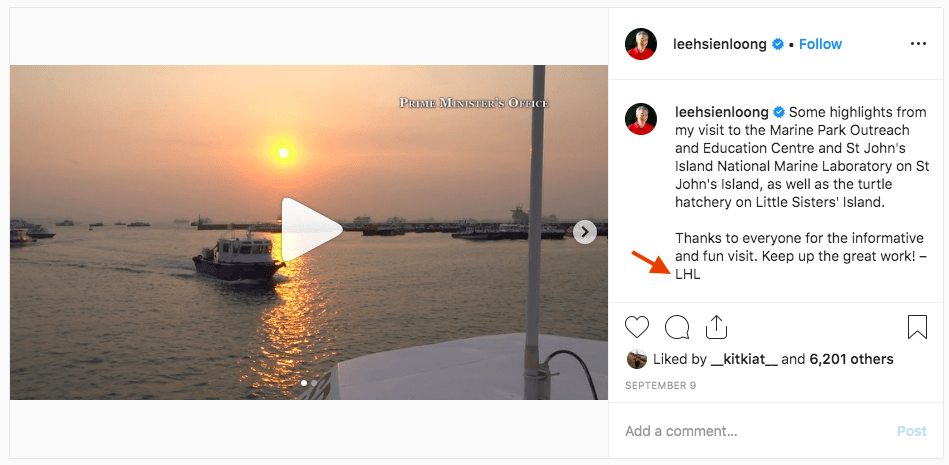
Ultimately, social media’s value as a political tool depends on the level of engagement the user achieves. While the number of followers is one aspect of that, a simple method to measure deeper engagement is to divide likes, shares, retweets, or comments by the total number of followers the poster has.
PM Lee, who averages about 253 shares per Facebook post, comes in at 0.02% shares-engagement when the figure is divided by his 1,266,627 followers. As for Instagram, the PM averages 5,300 likes per post from his 417,000 followers, with 1.2% likes-engagement on the platform. His engagement numbers are on the lower end of average, but they may be skewed because of PM Lee's disproportionately high number of followers compared with any other local politician.
Of course, likes, shares, and comments all mean different things. A ‘like’ is the easiest thing to do on social media – a double-tap, or a single click of a button. It implies, at times, agreement, but can sometimes be mindless. Say your favourite actress posts something on Instagram. Chances are before you have even read the caption, you have already double-tapped.
Shares, on the other hand, translate as public endorsements of politicians or their messages. At the very least, shares show that individuals want other people in their social circle to know that they support or agree with the poster. Comments also show a higher level of engagement – arguably, the highest. They show that a post has stirred a reaction, and indicate a willingness to spend time and energy engaging with the post.
On PM Lee’s Facebook and Instagram, a few cheeky selfies are often sprinkled into the mix which garners many likes. He also documents his meetings with international world leaders and makes an effort to explain the purpose and results of those meetings. Those posts see a higher volume of comments and shares when followers share their opinions on the relevant issues.
Other social media front-runners in Cabinet include Foreign Minister Vivian Balakrishnan, with 116K followers on Facebook, 66.4K on Twitter, and 17K on Instagram. He clocks 0.028% shares-engagement on Facebook, and 2.27% likes-engagement on Instagram – higher than the PM for both platforms, but with fewer than half the followers.
Law and Home Affairs Minister K Shanmugam sometimes takes to Facebook to sound out on issues that elicit high levels of public interest. Recently, he posted about a contentious molest case, which garnered over 10 times the amount of engagement his posts normally get.
He also takes things a step further with his Youtube channel, where he posts things like ‘A Day in My Life’, where you can see his early morning workout, watch his pet dogs, and catch a glimpse of government meetings. Followers cannot share their thoughts upon watching, however, since the comments section is disabled.
But not everyone uses all three platforms. Listed here are the politicians who use Facebook and Instagram, but not Twitter.
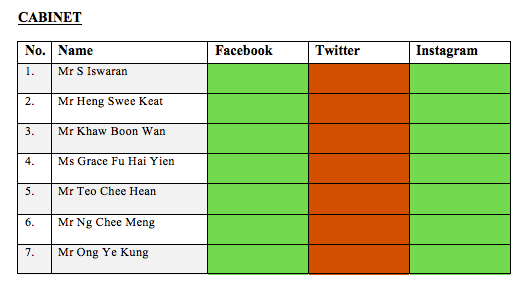



Then there are those who have Facebook and Twitter, but not Instagram.




Then there are those who only use one platform - Facebook.

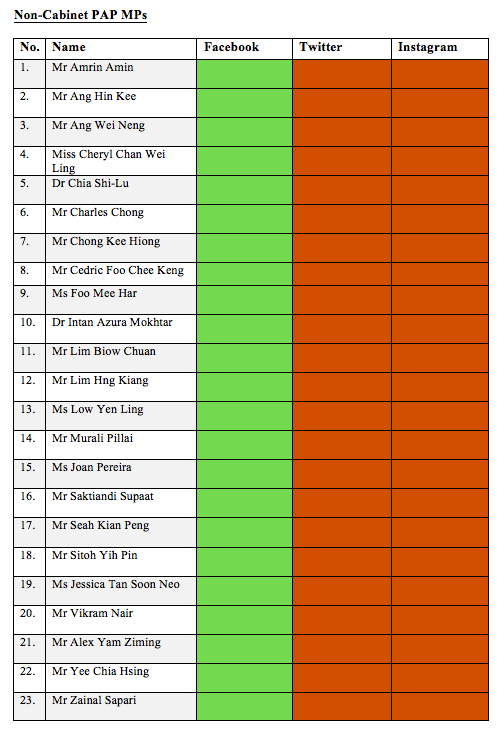
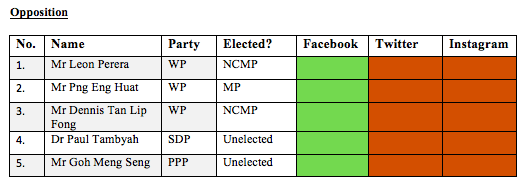

Only having one platform does not mean they have to settle for lower engagement or a less active social media presence. While Trade and Industry Minister Chan Chun Sing shares lengthy updates on ministry initiatives with his 42.4K Facebook followers, Minister Indranee Rajah keeps her captions short, opting to share more photos of herself and her constituents with her 21K followers. Aside from Cabinet, many members of parliament are also active on social media.
Finally, there are the few politicians who prefer to stay off social media. Among them are NMPs and veteran opposition politicians who have been on the scene for over two decades. Additionally, some politicians have private pages that are not accessible to the public. These pages are probably reserved for family and friends, and we have not included them in our tabulation.


Amongst the majority who do use at least Facebook, here are the top scorers among the non-Cabinet MPs, consisting of both PAP and opposition politicians.

Speaker of Parliament Tan Chuan Jin has been dubbed by some as Mr. Social Media, and for good reason. He runs accounts on Facebook, Twitter, and Instagram, and is ranked fourth among all local politicians in terms of Facebook following. He also adopts a more casual approach to social media than any other local politician, from content to tone. Plus, he posts some pretty interesting stories about stuff he experiences on the ground.
On Twitter, Tan posts bite-sized comments about soccer, foreign politics... and more soccer.
I imagine Fernandinho could play this role? Wealth of talent. https://t.co/GjPrIRoclz
— Tan Chuan-Jin (@chuanjin1) September 17, 2019
But perhaps he is best known for his use of Facebook Live, a feature few other politicians have been known to use. Tan has an affinity for sharing his experiences directly with his audience, and he covers everything from mock terror drills to raise security awareness, to sporting events featuring national athletes. Here, he live-streams himself interviewing a group of volunteers in Chai Chee.
MP Louis Ng has over 15K followers on Facebook, and he responds actively to his constituents when they raise concerns.

Then there is Emeritus Senior Minister Goh Chok Tong who has a unique online handle - he runs his Facebook and Twitter pages under the username of MParader, likely inspired by the 43 years he has served as an MP for the Marine Parade constituency. With 28.6K followers on Facebook and 5.2K on Twitter, Goh stands amongst the top-scorers in engagement.
But amidst the usual work photos and videos, Senior Parliamentary Secretary for the Ministry of Culture, Community and Youth and the Ministry of Transport Baey Yam Keng stands out as the non-cabinet MP with the highest Instagram following. He uses the platform to provide his followers with a dose of ‘fitspo’, frequently posting post-run selfies and workout videos.
On the Opposition side, Worker’s Party leader Pritam Singh’s 26.2K follower base on Facebook is a comment-happy bunch, with Singh responding to comments often and in-depth. At times, he debated current issues like climate change with his followers.

Dr Tan Cheng Bock of the Progress Singapore Party garners a 5.9% likes-engagement from his 5.1K followers on Instagram. For him, posting relatable stories about family seems to be a sure-fire way to gain engagement.
Reform Party leader Kenneth Jeyaratnam prefers to tweet, posting up to 10 times a day to his 2.5K followers on Twitter. He is one of few local politicians who use the platform, with most favouring Facebook and Instagram. However, with an average of 0.2 retweets per post, Jeyaratnam's Facebook page, where he posts less often but has five times the followers, garners more engagement. On Twitter, however, is where you'll find Jeyaratnam at his most unfiltered, as he openly speaks his minds about local and global politics and current issues.
Shocking given her harshness towards Amos Yee, a child at that time. She wanted to send him for Reformative Training which would have been one to three years of a military-style jail. https://t.co/5itwfDNlD3
— Kenneth Jeyaretnam (@KenJeyaretnam) September 27, 2019
Singapore Democratic Party leader Chee Soon Juan has an impressive 79K followers on Facebook, and stand-out comment rates. Despite the high following, Dr. Chee rarely replies to Facebook comments himself. Usually, an administrative user responds to constituents who bring up concerns.
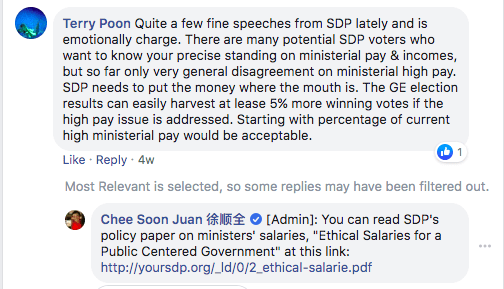

Evidently, differences abound in the ways our politicians use social media. Some post personal photos, some stick to photos of their work life. Some pen long, heartfelt captions, while others keep it short and to the point. A handful respond regularly to comments, some largely overlook them, while others disable the comments function. If one thing is constant, it is that nearly everyone from the Prime Minister to members of the opposition use social media platforms as a supporting tool in relationship-building with the citizenry. There is just one question left - will Low Thia Khiang ever get on Facebook?
Chandreyee Ray is a final-year NUS Communications and New Media Department undergraduate
Related stories
Town council websites to look at when you’re nostalgic for old-school internet
Parliament: Record number of motions filed by MPs
Parliament Q&A: Facts and figures can be touchy subjects too
Which MPs have asked the most questions in Parliament?
And the minister most often up on his own two feet was....


